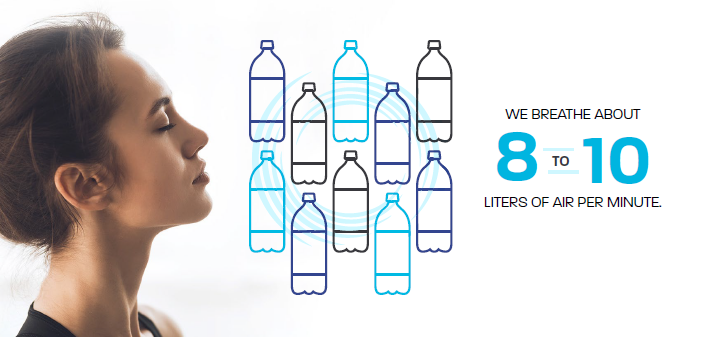The Business Benefits of Improving IAQ
In this post:
- How improving indoor air quality (IAQ) can reduce energy bills
- IAQ and your employees
- IAQ's impact on your bottom line
74% of North Americans suffer from ‘air quality anxiety’.
We help businesses ease those fears by focusing on IAQ improvements.
Creating and maintaining a safer workplace means taking steps to protect your space, including air and surfaces. In addition to other layered prevention strategies, taking actions to improve IAQ can reduce the risk of exposure to particles, aerosols, and other contaminants, and improve the health of building occupants. In a room with other people, we are constantly breathing in this shared air. We're here to help make your shared air better.
Let's take a look at the business benefits of improving your indoor air quality.
 Reduced Energy Use
Reduced Energy Use
According to the EPA, at least 45% of energy costs in commercial buildings are due to heating and cooling expenses. A study by the EPA shows the economic loss due to poor indoor air quality was in “tens of billions” of dollars per year and any investment towards good indoor air quality would generate substantial positive results.
The main factors that influence indoor air quality are airflow, thermal conditions, lighting, and odors and pollutants. It goes hand in hand that the expenses incurred to improve equipment, systems, and cleaning of air pollutants ultimately reduce the energy spent trying to maintain the temperature and air quality. In addition, using IAQ products like fans and evaporative coolers in warmer climates can help keep temperatures steady all year long, and keep heating and cooling costs in line.
A study conducted by the Berkeley labs explores the correlation between staff costs and the total building energy costs. For every dollar spent on maintaining optimal temperature, there have been economic benefits per worker as well.
 Better Employee Health & Productivity
Better Employee Health & Productivity
The Berkeley study above also demonstrated the cost/benefit analysis of changing ventilation rates. For example, they observed that the estimated financial benefits of improved work performance were around $600 per worker (based on $100K per worker) when the ventilation rate was changed between 15-20 cfm per person which produced an estimated improvement in the performance of around 0.6%.
Poor IAQ produces both building-related diseases as well as non-specific building-related illness (NSBRI), also referred to as sick-building syndrome. NSBRI is a condition where individuals develop symptoms from a build-up of irritants in the environment most likely associated with poor ventilation. Symptoms include headache, drowsiness, burning and irritation of the eyes, nose, and throat, and sometimes coughing. IAQ causes for NSBRI can be biological or chemical, but generally are at a concentration too low to cause identifiable disease. The illnesses usually do not culminate into long-term consequences outside the environment.
Improving your building’s IAQ is part of a successful prevention strategy to improve employee health and well-being.
 Reduced Absenteeism (and Increased Presenteeism) Amongst Employees
Reduced Absenteeism (and Increased Presenteeism) Amongst Employees
Investing in an IAQ improvement strategy can result in 5 fewer hours absent per year, per employee.
The negative health impacts of dust, dander, dampness, and allergens are well known. Less discussed is the harmful effect poor air quality has on worker absenteeism. Indeed, health-related absenteeism is a serious cost to businesses every year (these are absences above and beyond the occasional sick day). Absenteeism costs U.S. companies billions of dollars each year in lost productivity, wages, poor quality of goods/services, and excess management time.
Reduced absenteeism has been associated with a variety of IAQ-related factors, including improved ventilation rates, improved air filtration, and reduced dampness in buildings. In fact, according to an Embry-Riddle study, it was concluded that improvements in the indoor environment, such as increased ventilation, reduced recirculation of indoor air, and improved air filtration may reduce sick leave due to infectious diseases by 9 to 20 percent.
Of course, the best reason to maintain good air quality is to protect your workers. Think of how quickly illness or viruses like COVID-19 can spread via airborne particles among your staff. Not only would your business be losing an employee (or several) for an extended timeframe, but other workers will also most likely have to take on their responsibilities, adding to their workload, and increasing their stress levels. Another reason to improve IAQ? You can boost presenteeism, or increased productivity due to improved air conditions, as discussed previously.
 Increased Market Value
Increased Market Value
IAQ is one of the most economically beneficial elements of sustainability and building operations. Healthy buildings can utilize their IAQ programs as a powerful marketing tool for leasing, extending leases, or selling since it makes for a compelling value proposition due to the economic impact.
If you are thinking of introducing IAQ products to your facility, this is the best time to start your process. We have the experience, knowledge, and financing options to secure the right products for your building to help you improve your IAQ standards. Reach out to one of our Indoor Air Quality experts today.
Related Posts:
- Complete Air Quality Solutions for Every Space
- MERV Ratings, Explained
- Why The Best Companies Monitor Their Air (and Why You Should, Too)
Source: Berkeley Labs study of Cost Effectiveness of Improving Indoor Environments to Increase Productivity
We approach IAQ from a whole-facility perspective, with the goal of not only reducing contaminants in the air but also improving the comfort level of building occupants through air quality improvements.
Topics from this blog: Product Resources
Back



